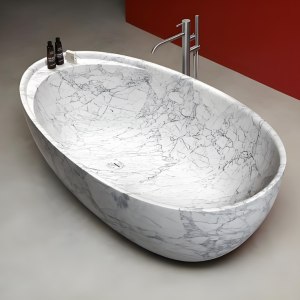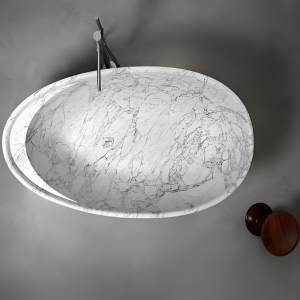Have you noticed some stubborn stains on your beautiful travertine bathtub recently? Do these annoying little fellas make you feel like your mood is destroyed? Don’t worry, this is part of our home life, and the good news is that these stains can be easily dealt with! Today we will discuss how to completely remove those troublesome marks without compromising the lovely surface of your travertine bathtub. Now let’s share some easy and enjoyable stain removal tips.

Understand the causes of stains
First, we need to understand where these stubborn stains come from. In fact, the main reason why travertine bathtubs grow these unpleasant “spots” is the accumulation of scale, soap residue and some cosmetics. One natural stone is travertine. Though it appears robust and sturdy, its surface is really porous, which causes it to readily absorb water and oils, so generating permanent stains over time.
In addition, areas with hard water are particularly prone to scale, and these minerals will accumulate and form a white film that is difficult to remove. Apart from appearance, these stains could compromise the surface of the bathtub, hence regular cleaning and maintenance are rather vital.
Importance of daily cleaning
The best way to avoid the formation of stubborn stains is to clean it promptly after daily use. It may sound a bit troublesome, but in fact, taking a few minutes to wipe the bathtub every day can greatly reduce the formation of stains. Surface residue can be readily handled with basic daily cleaning products like soft cloths or sponges and mild neutral detergues.
You can rinse the surface with warm water after each use of the bathtub and wipe it dry with a soft cloth to prevent scale from depositing. Though these little routines seem little, over time they will help to prevent the development of tenacious stains, thereby preserving the brightness of your bathtub as new.
Choose the right cleaning tools
Your first reaction might be to grab a powerful detergent and a brush to vigorously scrape tough stains. But don’t rush, travertine bathtubs are relatively delicate, and using improper cleaning tools may cause damage to its surface. We have to select certain instruments that will efficiently eliminate stains without compromising the surface of the bathtub.
First, avoid using hard brushes or metal scouring pads. They can degrade the surface of your bathtub and cause small scratches even when they can eliminate stains. Your bathtub should be cleaned with a soft-bristled brush, sponge, or soft rag. Microfiber cloths are also a good choice because they can effectively absorb dirt without scratching the surface.
Homemade cleaning solution
If you prefer natural and environmentally friendly cleaning methods, then homemade cleaning solutions are a good choice. These techniques are not only straightforward and quick to apply but also entirely cost-effective since they make use of common daily objects.
For limescale, for instance, a white vinegar and water combination works really well. All you have to do is 1:1 mix white vinegar and water, then spray it on the stain, let it sit for 15 minutes, then gently remove it with a sponge. The acid content of white vinegar can dissolve mineral deposits without damaging the travertine surface.
Should the stain be more resistant, try combining water with baking soda. Apply the paste made from the baking soda on the mark. After letting it for 20 to 30 minutes, softly brush it and lastly rinse it with fresh water. Without surface damage, the little baking soda particles can readily eliminate stains.
Use professional cleaners
Sometimes, stains are so stubborn that natural cleaners are no longer effective. You could now want to think about utilising some cleansers meant especially for natural stone. These cleaners usually have strong stain removal ability, but the ingredients are relatively mild and will not damage the travertine surface.
When choosing a professional cleaner, remember to read the product instructions carefully to ensure that it is designed specifically for natural stone and does not contain acidic or alkaline ingredients. Use additionally according to the directions to prevent too frequent surface contact or use.
Regular maintenance to extend the life of the bathtub
In addition to regular cleaning, it is also very important to maintain the travertine bathtub. Every now and then you could like to give the bathtub’s surface some stone sealer application. By creating a protective film on the bathtub’s surface, this sealant can help to lower the water stain absorption.
The frequency of use of the sealant depends on the usage. Usually, one should keep it maintained every six months to one year. You can raise the maintenance frequency suitably if your bathroom is used often or the water quality is rather hard. Before utilising the bathtub, make sure the surface is dry and clean; then, apply sealant evenly and wait for it to be completely absorbed.

Now you have a complete guide on how to remove stubborn stains from travertine bathtubs! Actually, cleaning travertine bathtubs is not too difficult as long as you pay attention to everyday cleaning, use the correct tools and techniques, and include frequent maintenance. Moreover, maintaining the bath as bright and clean as new will help you to keep your bathroom upscale and make every bath enjoyable. So, don’t be afraid of those stubborn stains, we have plenty of ways to deal with them!
Frequently Asked Question (FAQ)
How often should you seal your travertine bathtub?
Depending on how often you use the tub, how often you clean it, and how much foot traffic it gets, travertine bathtubs should be sealed periodically—typically every one to three years. You can also consider the type of sealer you use and how much the tub is exposed to moisture.
These guidelines apply to sealing travertine:
Use sealant during construction.
Don’t seal stained stone.
Keep the surface dry for minimum twelve hours.
Let the surface dry for at least 30 minutes between applications
Use a water test to see if it’s time to reapply the sealer: On the travertine, pour water in rings of 3 inches in diameter and let it sit for half an hour. It’s time to reseal if the tile remains dark after 15 minutes.
Sealing travertine protects its natural beauty and helps shield it from stains. It can also make the surface more durable and extend its life.





